Importance of Stakeholder Analysis in Company Operations
VerifiedAdded on 2023/01/23
|16
|4007
|91
AI Summary
This study highlights the importance of stakeholder analysis in company operations, discussing the roles and influence of internal and external stakeholders. It explores conflicting interests and the need to balance them for successful operations. The case study focuses on Coca-Cola and its stakeholder matrix.
Contribute Materials
Your contribution can guide someone’s learning journey. Share your
documents today.
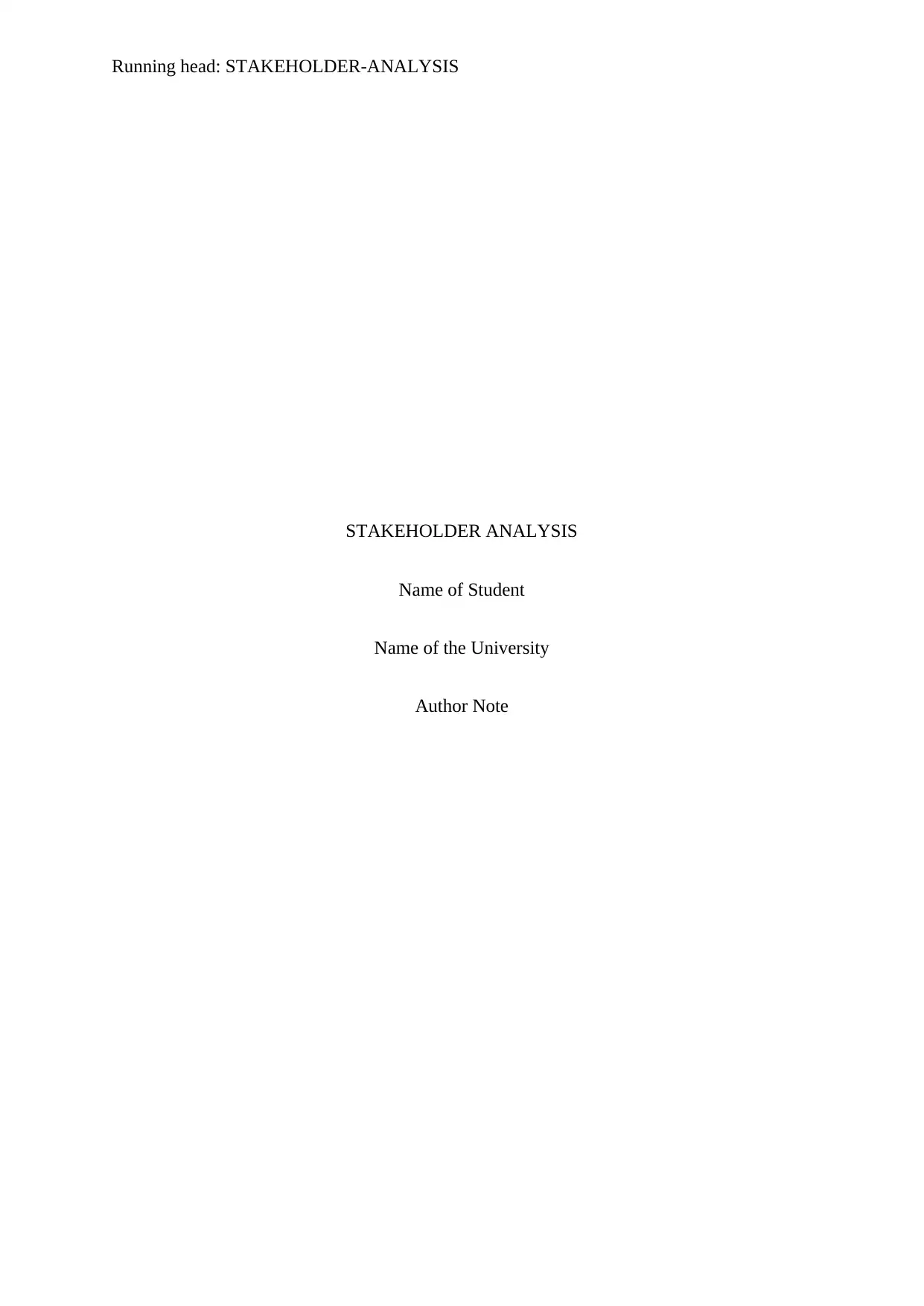
Running head: STAKEHOLDER-ANALYSIS
STAKEHOLDER ANALYSIS
Name of Student
Name of the University
Author Note
STAKEHOLDER ANALYSIS
Name of Student
Name of the University
Author Note
Secure Best Marks with AI Grader
Need help grading? Try our AI Grader for instant feedback on your assignments.
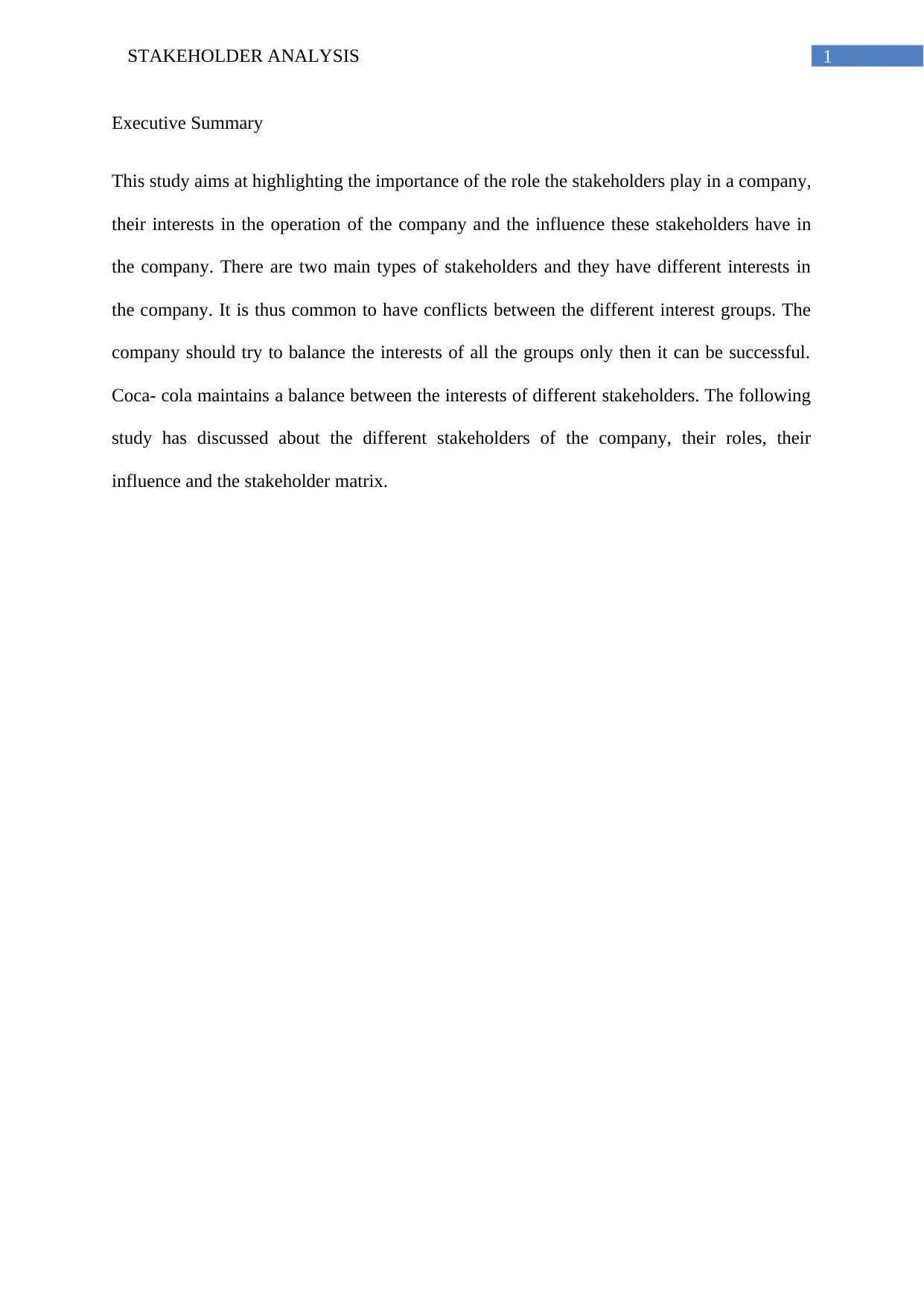
1STAKEHOLDER ANALYSIS
Executive Summary
This study aims at highlighting the importance of the role the stakeholders play in a company,
their interests in the operation of the company and the influence these stakeholders have in
the company. There are two main types of stakeholders and they have different interests in
the company. It is thus common to have conflicts between the different interest groups. The
company should try to balance the interests of all the groups only then it can be successful.
Coca- cola maintains a balance between the interests of different stakeholders. The following
study has discussed about the different stakeholders of the company, their roles, their
influence and the stakeholder matrix.
Executive Summary
This study aims at highlighting the importance of the role the stakeholders play in a company,
their interests in the operation of the company and the influence these stakeholders have in
the company. There are two main types of stakeholders and they have different interests in
the company. It is thus common to have conflicts between the different interest groups. The
company should try to balance the interests of all the groups only then it can be successful.
Coca- cola maintains a balance between the interests of different stakeholders. The following
study has discussed about the different stakeholders of the company, their roles, their
influence and the stakeholder matrix.
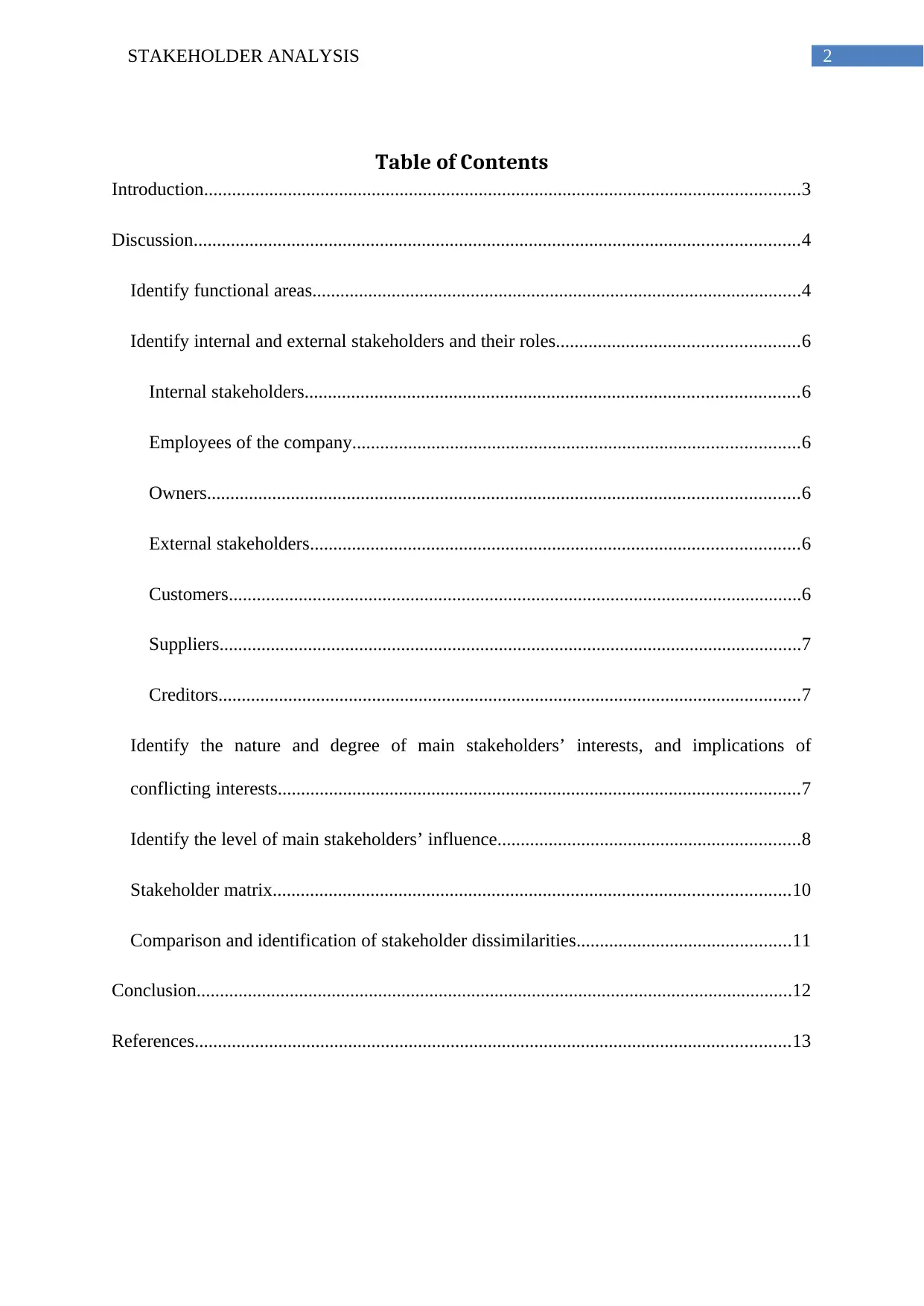
2STAKEHOLDER ANALYSIS
Table of Contents
Introduction................................................................................................................................3
Discussion..................................................................................................................................4
Identify functional areas.........................................................................................................4
Identify internal and external stakeholders and their roles....................................................6
Internal stakeholders..........................................................................................................6
Employees of the company................................................................................................6
Owners...............................................................................................................................6
External stakeholders.........................................................................................................6
Customers...........................................................................................................................6
Suppliers.............................................................................................................................7
Creditors.............................................................................................................................7
Identify the nature and degree of main stakeholders’ interests, and implications of
conflicting interests................................................................................................................7
Identify the level of main stakeholders’ influence.................................................................8
Stakeholder matrix...............................................................................................................10
Comparison and identification of stakeholder dissimilarities..............................................11
Conclusion................................................................................................................................12
References................................................................................................................................13
Table of Contents
Introduction................................................................................................................................3
Discussion..................................................................................................................................4
Identify functional areas.........................................................................................................4
Identify internal and external stakeholders and their roles....................................................6
Internal stakeholders..........................................................................................................6
Employees of the company................................................................................................6
Owners...............................................................................................................................6
External stakeholders.........................................................................................................6
Customers...........................................................................................................................6
Suppliers.............................................................................................................................7
Creditors.............................................................................................................................7
Identify the nature and degree of main stakeholders’ interests, and implications of
conflicting interests................................................................................................................7
Identify the level of main stakeholders’ influence.................................................................8
Stakeholder matrix...............................................................................................................10
Comparison and identification of stakeholder dissimilarities..............................................11
Conclusion................................................................................................................................12
References................................................................................................................................13
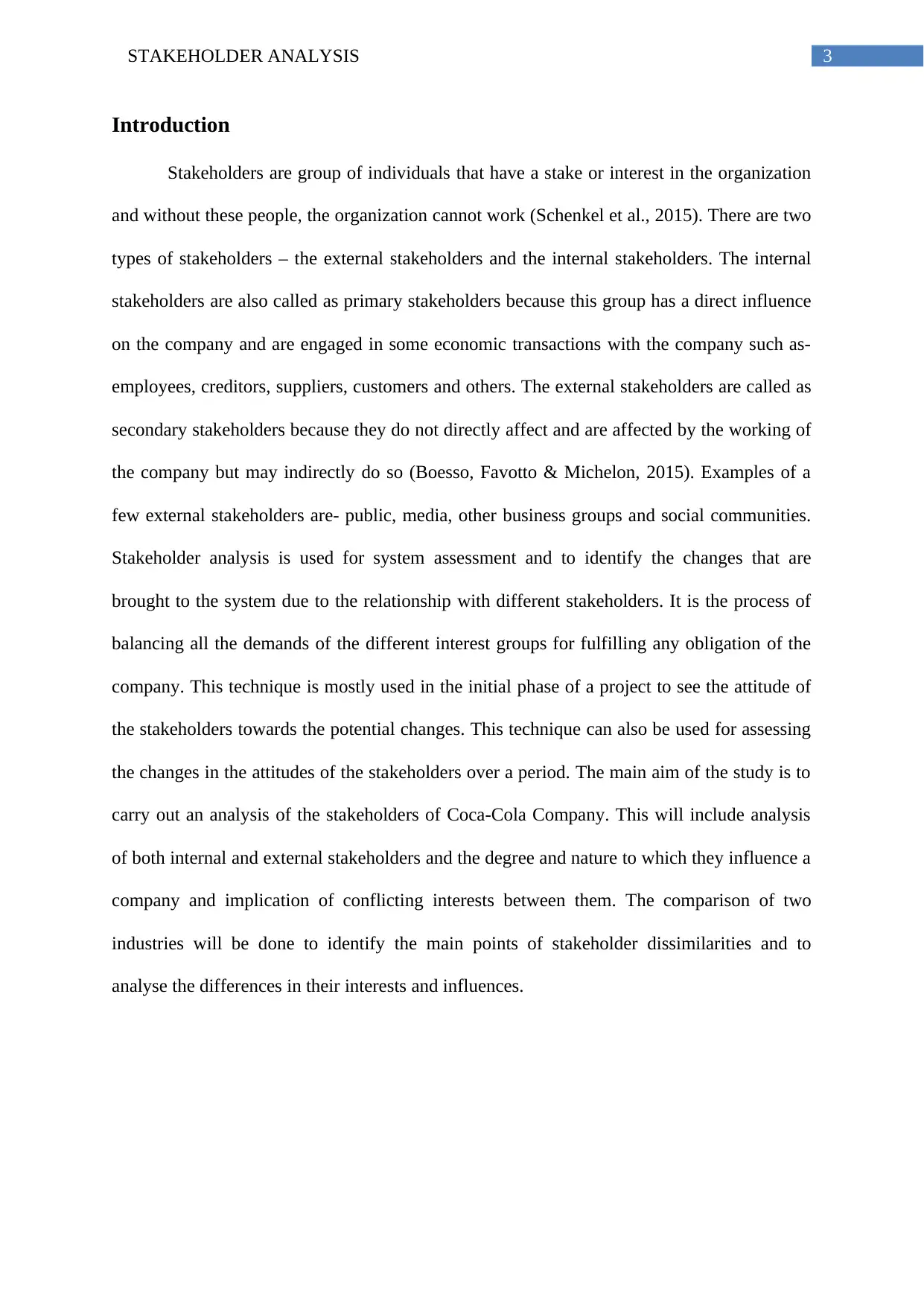
3STAKEHOLDER ANALYSIS
Introduction
Stakeholders are group of individuals that have a stake or interest in the organization
and without these people, the organization cannot work (Schenkel et al., 2015). There are two
types of stakeholders – the external stakeholders and the internal stakeholders. The internal
stakeholders are also called as primary stakeholders because this group has a direct influence
on the company and are engaged in some economic transactions with the company such as-
employees, creditors, suppliers, customers and others. The external stakeholders are called as
secondary stakeholders because they do not directly affect and are affected by the working of
the company but may indirectly do so (Boesso, Favotto & Michelon, 2015). Examples of a
few external stakeholders are- public, media, other business groups and social communities.
Stakeholder analysis is used for system assessment and to identify the changes that are
brought to the system due to the relationship with different stakeholders. It is the process of
balancing all the demands of the different interest groups for fulfilling any obligation of the
company. This technique is mostly used in the initial phase of a project to see the attitude of
the stakeholders towards the potential changes. This technique can also be used for assessing
the changes in the attitudes of the stakeholders over a period. The main aim of the study is to
carry out an analysis of the stakeholders of Coca-Cola Company. This will include analysis
of both internal and external stakeholders and the degree and nature to which they influence a
company and implication of conflicting interests between them. The comparison of two
industries will be done to identify the main points of stakeholder dissimilarities and to
analyse the differences in their interests and influences.
Introduction
Stakeholders are group of individuals that have a stake or interest in the organization
and without these people, the organization cannot work (Schenkel et al., 2015). There are two
types of stakeholders – the external stakeholders and the internal stakeholders. The internal
stakeholders are also called as primary stakeholders because this group has a direct influence
on the company and are engaged in some economic transactions with the company such as-
employees, creditors, suppliers, customers and others. The external stakeholders are called as
secondary stakeholders because they do not directly affect and are affected by the working of
the company but may indirectly do so (Boesso, Favotto & Michelon, 2015). Examples of a
few external stakeholders are- public, media, other business groups and social communities.
Stakeholder analysis is used for system assessment and to identify the changes that are
brought to the system due to the relationship with different stakeholders. It is the process of
balancing all the demands of the different interest groups for fulfilling any obligation of the
company. This technique is mostly used in the initial phase of a project to see the attitude of
the stakeholders towards the potential changes. This technique can also be used for assessing
the changes in the attitudes of the stakeholders over a period. The main aim of the study is to
carry out an analysis of the stakeholders of Coca-Cola Company. This will include analysis
of both internal and external stakeholders and the degree and nature to which they influence a
company and implication of conflicting interests between them. The comparison of two
industries will be done to identify the main points of stakeholder dissimilarities and to
analyse the differences in their interests and influences.
Secure Best Marks with AI Grader
Need help grading? Try our AI Grader for instant feedback on your assignments.
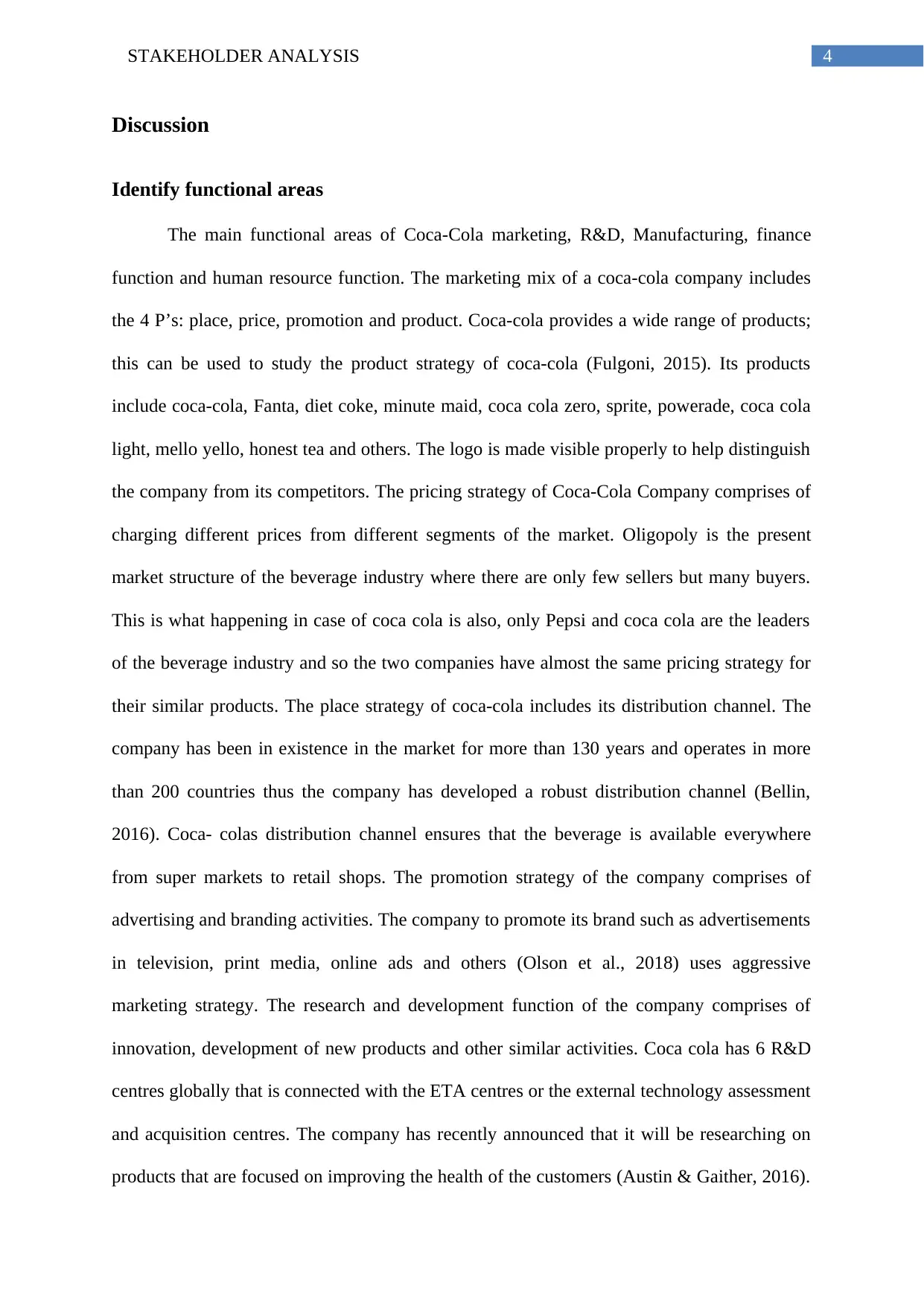
4STAKEHOLDER ANALYSIS
Discussion
Identify functional areas
The main functional areas of Coca-Cola marketing, R&D, Manufacturing, finance
function and human resource function. The marketing mix of a coca-cola company includes
the 4 P’s: place, price, promotion and product. Coca-cola provides a wide range of products;
this can be used to study the product strategy of coca-cola (Fulgoni, 2015). Its products
include coca-cola, Fanta, diet coke, minute maid, coca cola zero, sprite, powerade, coca cola
light, mello yello, honest tea and others. The logo is made visible properly to help distinguish
the company from its competitors. The pricing strategy of Coca-Cola Company comprises of
charging different prices from different segments of the market. Oligopoly is the present
market structure of the beverage industry where there are only few sellers but many buyers.
This is what happening in case of coca cola is also, only Pepsi and coca cola are the leaders
of the beverage industry and so the two companies have almost the same pricing strategy for
their similar products. The place strategy of coca-cola includes its distribution channel. The
company has been in existence in the market for more than 130 years and operates in more
than 200 countries thus the company has developed a robust distribution channel (Bellin,
2016). Coca- colas distribution channel ensures that the beverage is available everywhere
from super markets to retail shops. The promotion strategy of the company comprises of
advertising and branding activities. The company to promote its brand such as advertisements
in television, print media, online ads and others (Olson et al., 2018) uses aggressive
marketing strategy. The research and development function of the company comprises of
innovation, development of new products and other similar activities. Coca cola has 6 R&D
centres globally that is connected with the ETA centres or the external technology assessment
and acquisition centres. The company has recently announced that it will be researching on
products that are focused on improving the health of the customers (Austin & Gaither, 2016).
Discussion
Identify functional areas
The main functional areas of Coca-Cola marketing, R&D, Manufacturing, finance
function and human resource function. The marketing mix of a coca-cola company includes
the 4 P’s: place, price, promotion and product. Coca-cola provides a wide range of products;
this can be used to study the product strategy of coca-cola (Fulgoni, 2015). Its products
include coca-cola, Fanta, diet coke, minute maid, coca cola zero, sprite, powerade, coca cola
light, mello yello, honest tea and others. The logo is made visible properly to help distinguish
the company from its competitors. The pricing strategy of Coca-Cola Company comprises of
charging different prices from different segments of the market. Oligopoly is the present
market structure of the beverage industry where there are only few sellers but many buyers.
This is what happening in case of coca cola is also, only Pepsi and coca cola are the leaders
of the beverage industry and so the two companies have almost the same pricing strategy for
their similar products. The place strategy of coca-cola includes its distribution channel. The
company has been in existence in the market for more than 130 years and operates in more
than 200 countries thus the company has developed a robust distribution channel (Bellin,
2016). Coca- colas distribution channel ensures that the beverage is available everywhere
from super markets to retail shops. The promotion strategy of the company comprises of
advertising and branding activities. The company to promote its brand such as advertisements
in television, print media, online ads and others (Olson et al., 2018) uses aggressive
marketing strategy. The research and development function of the company comprises of
innovation, development of new products and other similar activities. Coca cola has 6 R&D
centres globally that is connected with the ETA centres or the external technology assessment
and acquisition centres. The company has recently announced that it will be researching on
products that are focused on improving the health of the customers (Austin & Gaither, 2016).
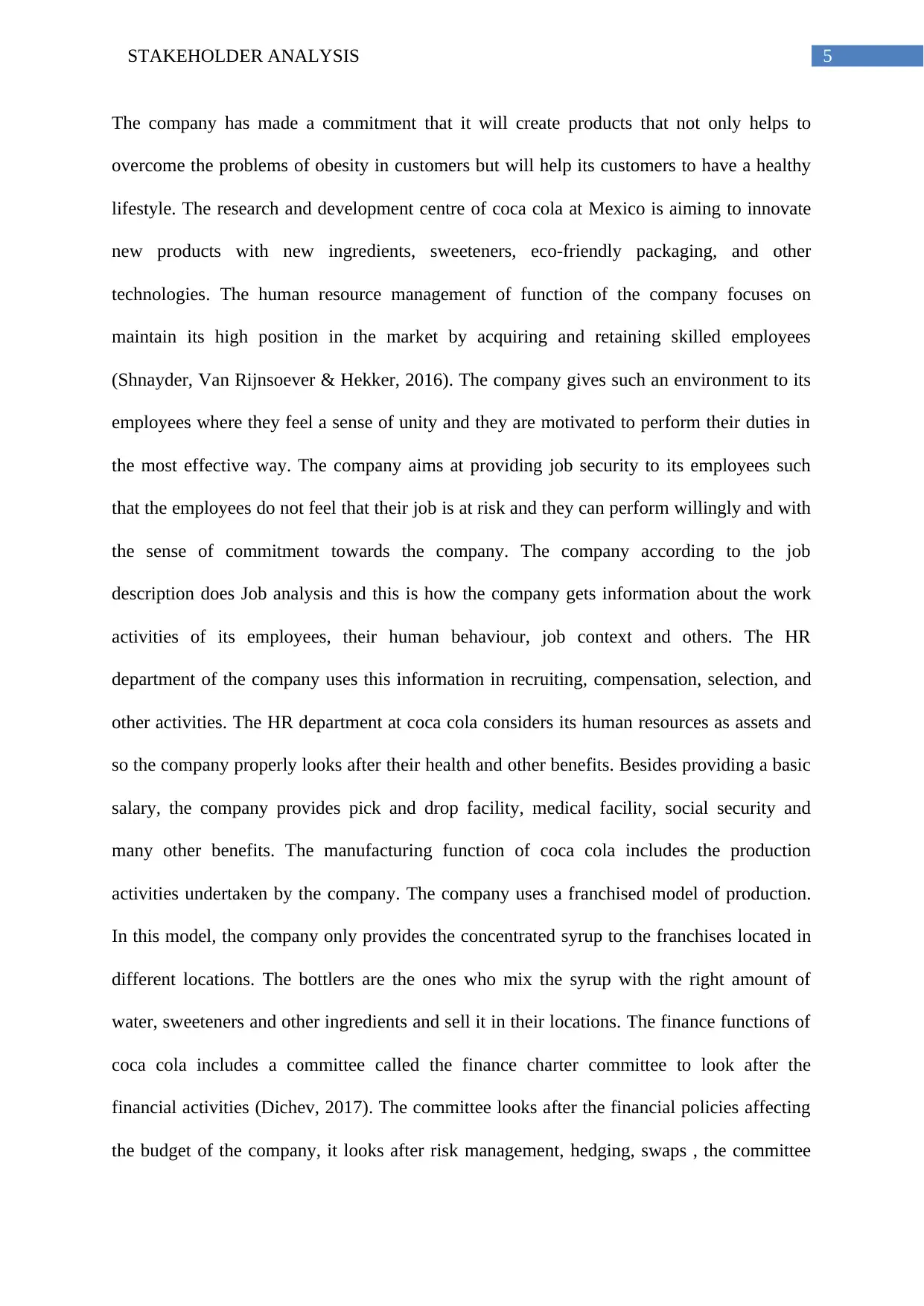
5STAKEHOLDER ANALYSIS
The company has made a commitment that it will create products that not only helps to
overcome the problems of obesity in customers but will help its customers to have a healthy
lifestyle. The research and development centre of coca cola at Mexico is aiming to innovate
new products with new ingredients, sweeteners, eco-friendly packaging, and other
technologies. The human resource management of function of the company focuses on
maintain its high position in the market by acquiring and retaining skilled employees
(Shnayder, Van Rijnsoever & Hekker, 2016). The company gives such an environment to its
employees where they feel a sense of unity and they are motivated to perform their duties in
the most effective way. The company aims at providing job security to its employees such
that the employees do not feel that their job is at risk and they can perform willingly and with
the sense of commitment towards the company. The company according to the job
description does Job analysis and this is how the company gets information about the work
activities of its employees, their human behaviour, job context and others. The HR
department of the company uses this information in recruiting, compensation, selection, and
other activities. The HR department at coca cola considers its human resources as assets and
so the company properly looks after their health and other benefits. Besides providing a basic
salary, the company provides pick and drop facility, medical facility, social security and
many other benefits. The manufacturing function of coca cola includes the production
activities undertaken by the company. The company uses a franchised model of production.
In this model, the company only provides the concentrated syrup to the franchises located in
different locations. The bottlers are the ones who mix the syrup with the right amount of
water, sweeteners and other ingredients and sell it in their locations. The finance functions of
coca cola includes a committee called the finance charter committee to look after the
financial activities (Dichev, 2017). The committee looks after the financial policies affecting
the budget of the company, it looks after risk management, hedging, swaps , the committee
The company has made a commitment that it will create products that not only helps to
overcome the problems of obesity in customers but will help its customers to have a healthy
lifestyle. The research and development centre of coca cola at Mexico is aiming to innovate
new products with new ingredients, sweeteners, eco-friendly packaging, and other
technologies. The human resource management of function of the company focuses on
maintain its high position in the market by acquiring and retaining skilled employees
(Shnayder, Van Rijnsoever & Hekker, 2016). The company gives such an environment to its
employees where they feel a sense of unity and they are motivated to perform their duties in
the most effective way. The company aims at providing job security to its employees such
that the employees do not feel that their job is at risk and they can perform willingly and with
the sense of commitment towards the company. The company according to the job
description does Job analysis and this is how the company gets information about the work
activities of its employees, their human behaviour, job context and others. The HR
department of the company uses this information in recruiting, compensation, selection, and
other activities. The HR department at coca cola considers its human resources as assets and
so the company properly looks after their health and other benefits. Besides providing a basic
salary, the company provides pick and drop facility, medical facility, social security and
many other benefits. The manufacturing function of coca cola includes the production
activities undertaken by the company. The company uses a franchised model of production.
In this model, the company only provides the concentrated syrup to the franchises located in
different locations. The bottlers are the ones who mix the syrup with the right amount of
water, sweeteners and other ingredients and sell it in their locations. The finance functions of
coca cola includes a committee called the finance charter committee to look after the
financial activities (Dichev, 2017). The committee looks after the financial policies affecting
the budget of the company, it looks after risk management, hedging, swaps , the committee
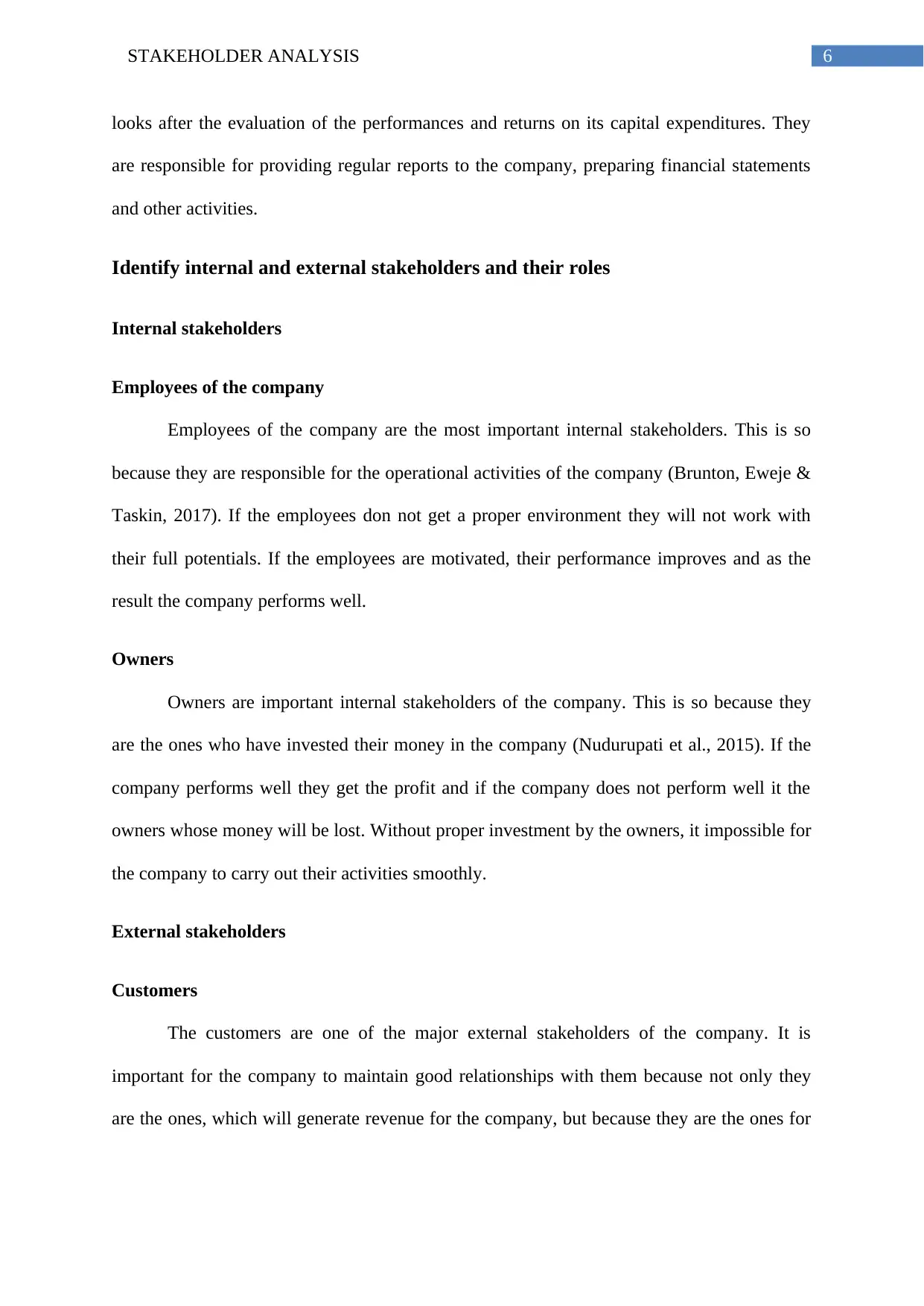
6STAKEHOLDER ANALYSIS
looks after the evaluation of the performances and returns on its capital expenditures. They
are responsible for providing regular reports to the company, preparing financial statements
and other activities.
Identify internal and external stakeholders and their roles
Internal stakeholders
Employees of the company
Employees of the company are the most important internal stakeholders. This is so
because they are responsible for the operational activities of the company (Brunton, Eweje &
Taskin, 2017). If the employees don not get a proper environment they will not work with
their full potentials. If the employees are motivated, their performance improves and as the
result the company performs well.
Owners
Owners are important internal stakeholders of the company. This is so because they
are the ones who have invested their money in the company (Nudurupati et al., 2015). If the
company performs well they get the profit and if the company does not perform well it the
owners whose money will be lost. Without proper investment by the owners, it impossible for
the company to carry out their activities smoothly.
External stakeholders
Customers
The customers are one of the major external stakeholders of the company. It is
important for the company to maintain good relationships with them because not only they
are the ones, which will generate revenue for the company, but because they are the ones for
looks after the evaluation of the performances and returns on its capital expenditures. They
are responsible for providing regular reports to the company, preparing financial statements
and other activities.
Identify internal and external stakeholders and their roles
Internal stakeholders
Employees of the company
Employees of the company are the most important internal stakeholders. This is so
because they are responsible for the operational activities of the company (Brunton, Eweje &
Taskin, 2017). If the employees don not get a proper environment they will not work with
their full potentials. If the employees are motivated, their performance improves and as the
result the company performs well.
Owners
Owners are important internal stakeholders of the company. This is so because they
are the ones who have invested their money in the company (Nudurupati et al., 2015). If the
company performs well they get the profit and if the company does not perform well it the
owners whose money will be lost. Without proper investment by the owners, it impossible for
the company to carry out their activities smoothly.
External stakeholders
Customers
The customers are one of the major external stakeholders of the company. It is
important for the company to maintain good relationships with them because not only they
are the ones, which will generate revenue for the company, but because they are the ones for
Paraphrase This Document
Need a fresh take? Get an instant paraphrase of this document with our AI Paraphraser

7STAKEHOLDER ANALYSIS
whom the company is operating (Batty, 2016). Without satisfied customers, the company
cannot exist in the market.
Suppliers
The suppliers of the coca-cola company are the external stakeholders because they
are the ones who help the company in meeting the needs of the customers properly. The
suppliers provide the company with necessary raw material such that the company can
produce best quality products and satisfy the needs of the customers (Henisz, 2017).
Creditors
Creditors are the external stakeholders of the company. The company carries out
investor assessment activities and thus the company prepares various important reports such
as financial statement and others. The creditors of the company play an important role in the
decision making process of the company (Chan & Oppong, 2017).
Identify the nature and degree of main stakeholders’ interests, and implications
of conflicting interests
The company organizes a stakeholder engagement programme for meeting the
stakeholder’s interest in the company. Coca cola feels that it is important to have an insight
into the stakeholder’s interest because their interests will help the company in producing such
products and providing such services that can keep them satisfied. The company helps in
meeting the interests of the employees by helping them build a sense of pride for working in
the company. The employees feel that they are meeting the needs of the customers in a much
better way than anyone else is by providing them with a variety of products. The company is
also provides a healthy working environment for the employees of the company. They
provide gratuity benefits, pick up and drop facilities to the employees of the company,
provide them with a sense of job security. The employees want proper training and
whom the company is operating (Batty, 2016). Without satisfied customers, the company
cannot exist in the market.
Suppliers
The suppliers of the coca-cola company are the external stakeholders because they
are the ones who help the company in meeting the needs of the customers properly. The
suppliers provide the company with necessary raw material such that the company can
produce best quality products and satisfy the needs of the customers (Henisz, 2017).
Creditors
Creditors are the external stakeholders of the company. The company carries out
investor assessment activities and thus the company prepares various important reports such
as financial statement and others. The creditors of the company play an important role in the
decision making process of the company (Chan & Oppong, 2017).
Identify the nature and degree of main stakeholders’ interests, and implications
of conflicting interests
The company organizes a stakeholder engagement programme for meeting the
stakeholder’s interest in the company. Coca cola feels that it is important to have an insight
into the stakeholder’s interest because their interests will help the company in producing such
products and providing such services that can keep them satisfied. The company helps in
meeting the interests of the employees by helping them build a sense of pride for working in
the company. The employees feel that they are meeting the needs of the customers in a much
better way than anyone else is by providing them with a variety of products. The company is
also provides a healthy working environment for the employees of the company. They
provide gratuity benefits, pick up and drop facilities to the employees of the company,
provide them with a sense of job security. The employees want proper training and

8STAKEHOLDER ANALYSIS
development before actual operations so that they can understand the working off the
company. This is where there arises a conflict between the interest of the employees and the
management (Wang et al., 2016). The owners who are also an important internal stakeholder
want more profits as a return on the capital invested by them. They find ways of reducing the
cost to be incurred on the employees because only then they can earn more. The owners and
the management try to reduce the cost on training and development by reducing the time of
training and other ways but the employees do not like this. Employees want more training so
that they can perform well when they start their operations. In this case, the company can
reach an agreement regarding training cost. The training should be such that the employees
are satisfied and the cost should be bearable to the company so that their profits are not
affected. The customers who are one of the major stakeholders of the company want their
products of good quality at an economic cost so that they do not feel that they are paying
more than the value they are getting from such payment (Alexander, 2015). The company on
the other hand may have to use improved techniques of production and manufacturing, have
to use better and safer ingredients to meet the requirements of the customers. However, this
may lead to increasing the price of the commodities that is not acceptable to the customers.
Hence, the company should try to produce its product using such techniques that can lead to
cost reduction and thereby offering the products at such a price, which is acceptable to
customers.
Identify the level of main stakeholders’ influence
The owners or the shareholders are main internal stakeholders of the company and
their interest lies in earning increased profits for the organization, increased growth in the
share market and others. For this, the shareholders want the company to expand globally and
see that the consumption of their products increases so that their market shares can increase.
Therefore, the shareholders and owners interest influences decisions of distribution channel,
development before actual operations so that they can understand the working off the
company. This is where there arises a conflict between the interest of the employees and the
management (Wang et al., 2016). The owners who are also an important internal stakeholder
want more profits as a return on the capital invested by them. They find ways of reducing the
cost to be incurred on the employees because only then they can earn more. The owners and
the management try to reduce the cost on training and development by reducing the time of
training and other ways but the employees do not like this. Employees want more training so
that they can perform well when they start their operations. In this case, the company can
reach an agreement regarding training cost. The training should be such that the employees
are satisfied and the cost should be bearable to the company so that their profits are not
affected. The customers who are one of the major stakeholders of the company want their
products of good quality at an economic cost so that they do not feel that they are paying
more than the value they are getting from such payment (Alexander, 2015). The company on
the other hand may have to use improved techniques of production and manufacturing, have
to use better and safer ingredients to meet the requirements of the customers. However, this
may lead to increasing the price of the commodities that is not acceptable to the customers.
Hence, the company should try to produce its product using such techniques that can lead to
cost reduction and thereby offering the products at such a price, which is acceptable to
customers.
Identify the level of main stakeholders’ influence
The owners or the shareholders are main internal stakeholders of the company and
their interest lies in earning increased profits for the organization, increased growth in the
share market and others. For this, the shareholders want the company to expand globally and
see that the consumption of their products increases so that their market shares can increase.
Therefore, the shareholders and owners interest influences decisions of distribution channel,
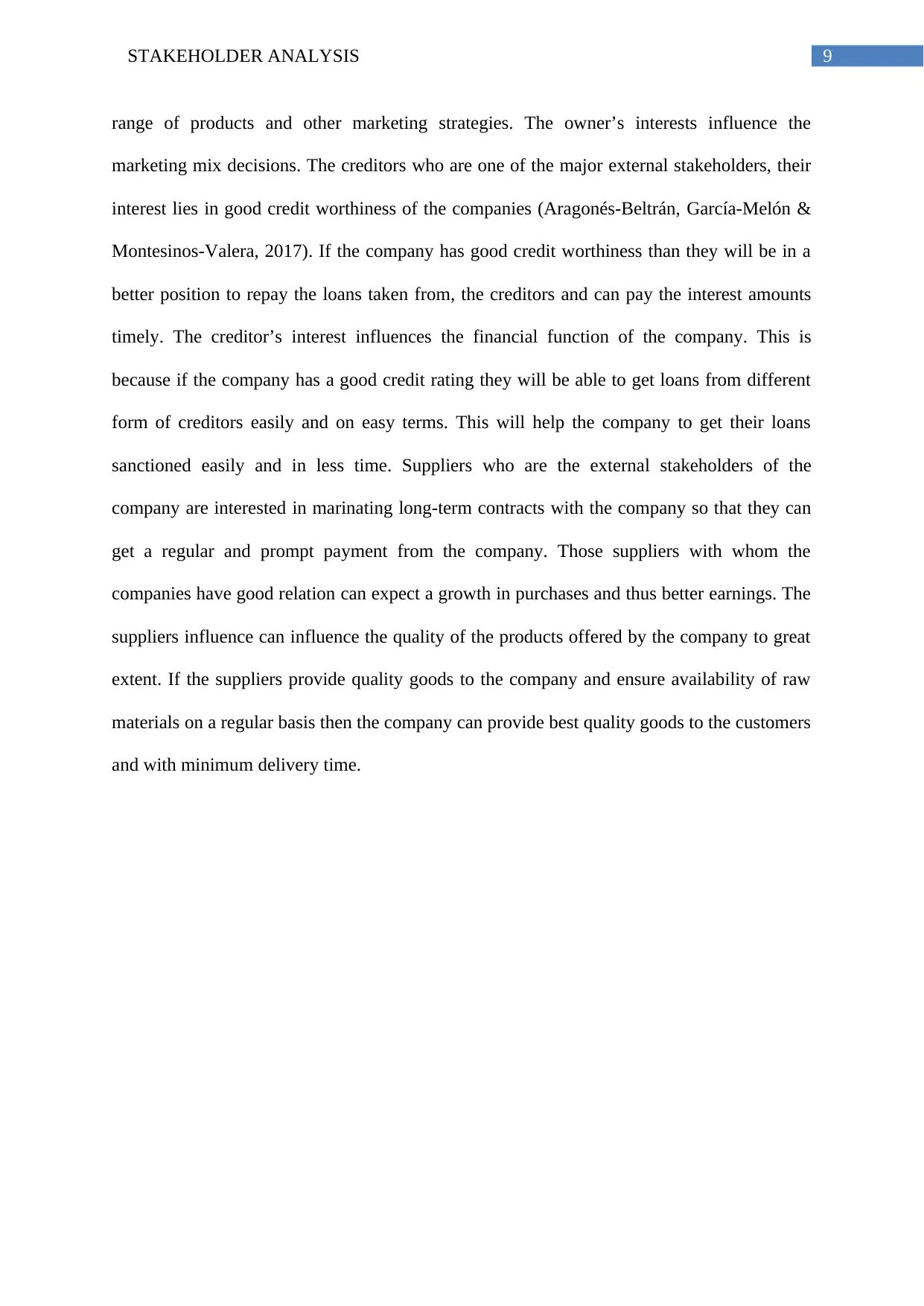
9STAKEHOLDER ANALYSIS
range of products and other marketing strategies. The owner’s interests influence the
marketing mix decisions. The creditors who are one of the major external stakeholders, their
interest lies in good credit worthiness of the companies (Aragonés-Beltrán, García-Melón &
Montesinos-Valera, 2017). If the company has good credit worthiness than they will be in a
better position to repay the loans taken from, the creditors and can pay the interest amounts
timely. The creditor’s interest influences the financial function of the company. This is
because if the company has a good credit rating they will be able to get loans from different
form of creditors easily and on easy terms. This will help the company to get their loans
sanctioned easily and in less time. Suppliers who are the external stakeholders of the
company are interested in marinating long-term contracts with the company so that they can
get a regular and prompt payment from the company. Those suppliers with whom the
companies have good relation can expect a growth in purchases and thus better earnings. The
suppliers influence can influence the quality of the products offered by the company to great
extent. If the suppliers provide quality goods to the company and ensure availability of raw
materials on a regular basis then the company can provide best quality goods to the customers
and with minimum delivery time.
range of products and other marketing strategies. The owner’s interests influence the
marketing mix decisions. The creditors who are one of the major external stakeholders, their
interest lies in good credit worthiness of the companies (Aragonés-Beltrán, García-Melón &
Montesinos-Valera, 2017). If the company has good credit worthiness than they will be in a
better position to repay the loans taken from, the creditors and can pay the interest amounts
timely. The creditor’s interest influences the financial function of the company. This is
because if the company has a good credit rating they will be able to get loans from different
form of creditors easily and on easy terms. This will help the company to get their loans
sanctioned easily and in less time. Suppliers who are the external stakeholders of the
company are interested in marinating long-term contracts with the company so that they can
get a regular and prompt payment from the company. Those suppliers with whom the
companies have good relation can expect a growth in purchases and thus better earnings. The
suppliers influence can influence the quality of the products offered by the company to great
extent. If the suppliers provide quality goods to the company and ensure availability of raw
materials on a regular basis then the company can provide best quality goods to the customers
and with minimum delivery time.
Secure Best Marks with AI Grader
Need help grading? Try our AI Grader for instant feedback on your assignments.

10STAKEHOLDER ANALYSIS
Stakeholder matrix
keep satisfied Key players
Minimum efforts Keep informed
Interest of the stakeholders
Influence of the stakeholders
Figure 1: stakeholder matrix
(Source: created by author)
Stakeholder matrix
keep satisfied Key players
Minimum efforts Keep informed
Interest of the stakeholders
Influence of the stakeholders
Figure 1: stakeholder matrix
(Source: created by author)
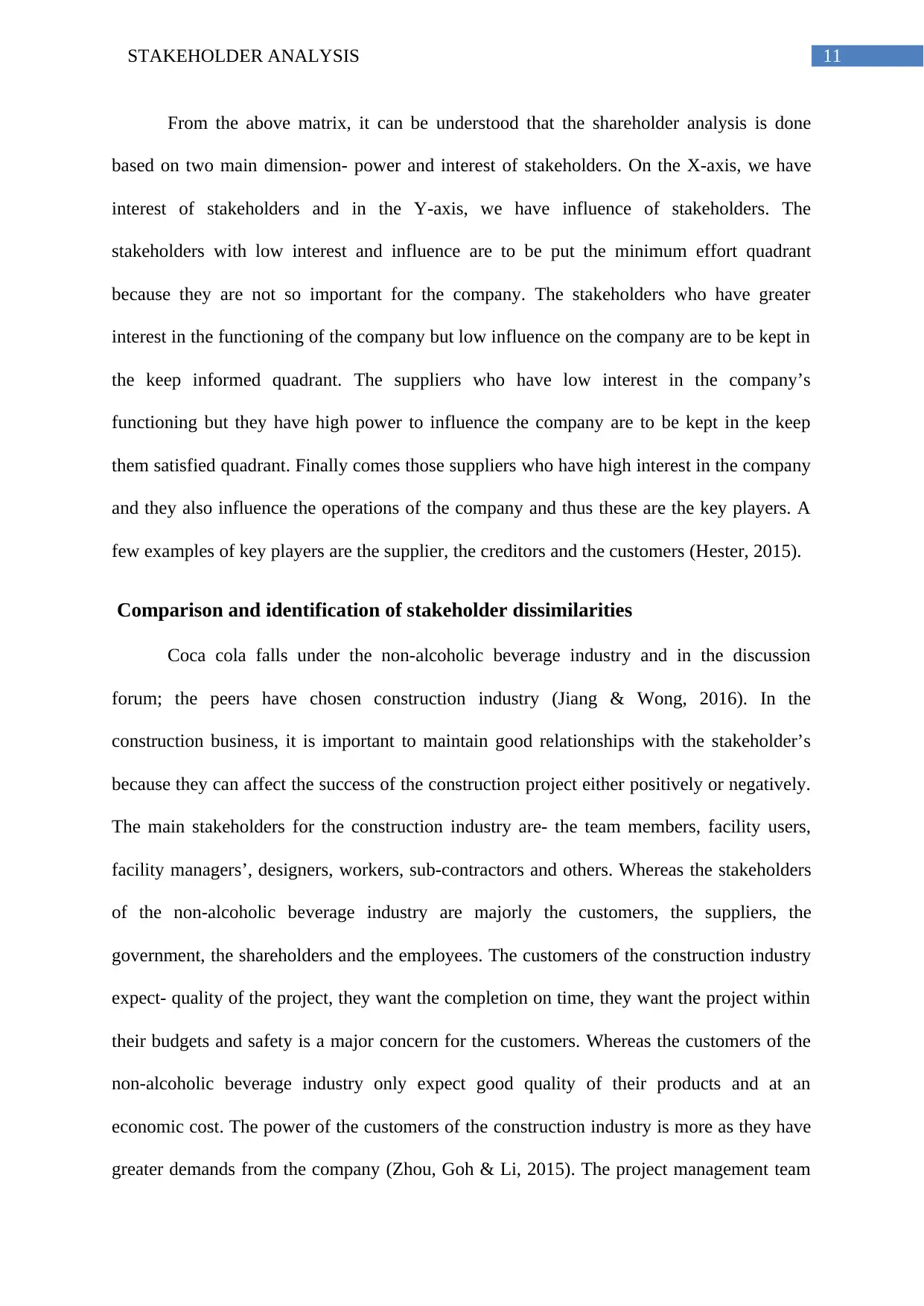
11STAKEHOLDER ANALYSIS
From the above matrix, it can be understood that the shareholder analysis is done
based on two main dimension- power and interest of stakeholders. On the X-axis, we have
interest of stakeholders and in the Y-axis, we have influence of stakeholders. The
stakeholders with low interest and influence are to be put the minimum effort quadrant
because they are not so important for the company. The stakeholders who have greater
interest in the functioning of the company but low influence on the company are to be kept in
the keep informed quadrant. The suppliers who have low interest in the company’s
functioning but they have high power to influence the company are to be kept in the keep
them satisfied quadrant. Finally comes those suppliers who have high interest in the company
and they also influence the operations of the company and thus these are the key players. A
few examples of key players are the supplier, the creditors and the customers (Hester, 2015).
Comparison and identification of stakeholder dissimilarities
Coca cola falls under the non-alcoholic beverage industry and in the discussion
forum; the peers have chosen construction industry (Jiang & Wong, 2016). In the
construction business, it is important to maintain good relationships with the stakeholder’s
because they can affect the success of the construction project either positively or negatively.
The main stakeholders for the construction industry are- the team members, facility users,
facility managers’, designers, workers, sub-contractors and others. Whereas the stakeholders
of the non-alcoholic beverage industry are majorly the customers, the suppliers, the
government, the shareholders and the employees. The customers of the construction industry
expect- quality of the project, they want the completion on time, they want the project within
their budgets and safety is a major concern for the customers. Whereas the customers of the
non-alcoholic beverage industry only expect good quality of their products and at an
economic cost. The power of the customers of the construction industry is more as they have
greater demands from the company (Zhou, Goh & Li, 2015). The project management team
From the above matrix, it can be understood that the shareholder analysis is done
based on two main dimension- power and interest of stakeholders. On the X-axis, we have
interest of stakeholders and in the Y-axis, we have influence of stakeholders. The
stakeholders with low interest and influence are to be put the minimum effort quadrant
because they are not so important for the company. The stakeholders who have greater
interest in the functioning of the company but low influence on the company are to be kept in
the keep informed quadrant. The suppliers who have low interest in the company’s
functioning but they have high power to influence the company are to be kept in the keep
them satisfied quadrant. Finally comes those suppliers who have high interest in the company
and they also influence the operations of the company and thus these are the key players. A
few examples of key players are the supplier, the creditors and the customers (Hester, 2015).
Comparison and identification of stakeholder dissimilarities
Coca cola falls under the non-alcoholic beverage industry and in the discussion
forum; the peers have chosen construction industry (Jiang & Wong, 2016). In the
construction business, it is important to maintain good relationships with the stakeholder’s
because they can affect the success of the construction project either positively or negatively.
The main stakeholders for the construction industry are- the team members, facility users,
facility managers’, designers, workers, sub-contractors and others. Whereas the stakeholders
of the non-alcoholic beverage industry are majorly the customers, the suppliers, the
government, the shareholders and the employees. The customers of the construction industry
expect- quality of the project, they want the completion on time, they want the project within
their budgets and safety is a major concern for the customers. Whereas the customers of the
non-alcoholic beverage industry only expect good quality of their products and at an
economic cost. The power of the customers of the construction industry is more as they have
greater demands from the company (Zhou, Goh & Li, 2015). The project management team
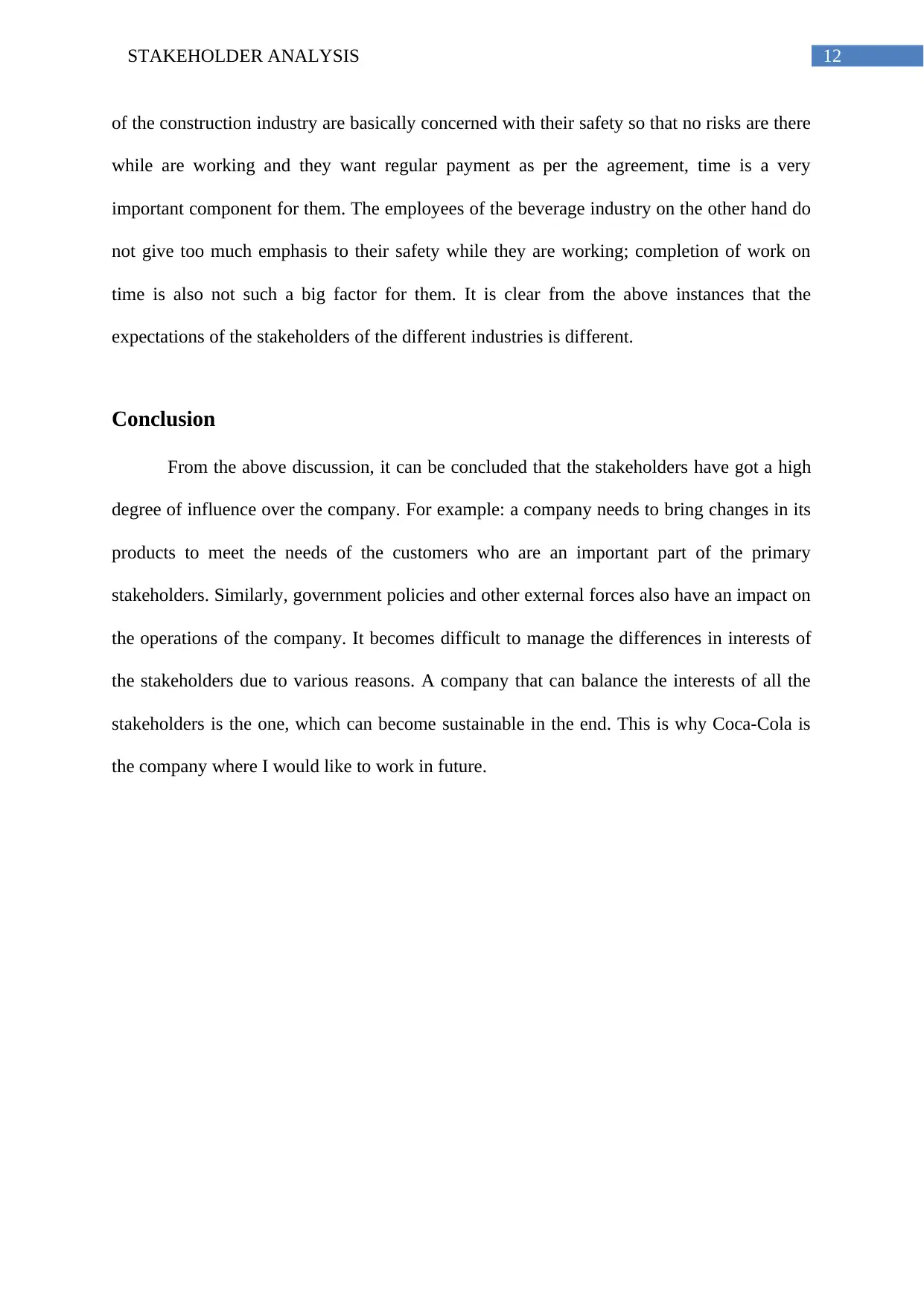
12STAKEHOLDER ANALYSIS
of the construction industry are basically concerned with their safety so that no risks are there
while are working and they want regular payment as per the agreement, time is a very
important component for them. The employees of the beverage industry on the other hand do
not give too much emphasis to their safety while they are working; completion of work on
time is also not such a big factor for them. It is clear from the above instances that the
expectations of the stakeholders of the different industries is different.
Conclusion
From the above discussion, it can be concluded that the stakeholders have got a high
degree of influence over the company. For example: a company needs to bring changes in its
products to meet the needs of the customers who are an important part of the primary
stakeholders. Similarly, government policies and other external forces also have an impact on
the operations of the company. It becomes difficult to manage the differences in interests of
the stakeholders due to various reasons. A company that can balance the interests of all the
stakeholders is the one, which can become sustainable in the end. This is why Coca-Cola is
the company where I would like to work in future.
of the construction industry are basically concerned with their safety so that no risks are there
while are working and they want regular payment as per the agreement, time is a very
important component for them. The employees of the beverage industry on the other hand do
not give too much emphasis to their safety while they are working; completion of work on
time is also not such a big factor for them. It is clear from the above instances that the
expectations of the stakeholders of the different industries is different.
Conclusion
From the above discussion, it can be concluded that the stakeholders have got a high
degree of influence over the company. For example: a company needs to bring changes in its
products to meet the needs of the customers who are an important part of the primary
stakeholders. Similarly, government policies and other external forces also have an impact on
the operations of the company. It becomes difficult to manage the differences in interests of
the stakeholders due to various reasons. A company that can balance the interests of all the
stakeholders is the one, which can become sustainable in the end. This is why Coca-Cola is
the company where I would like to work in future.
Paraphrase This Document
Need a fresh take? Get an instant paraphrase of this document with our AI Paraphraser
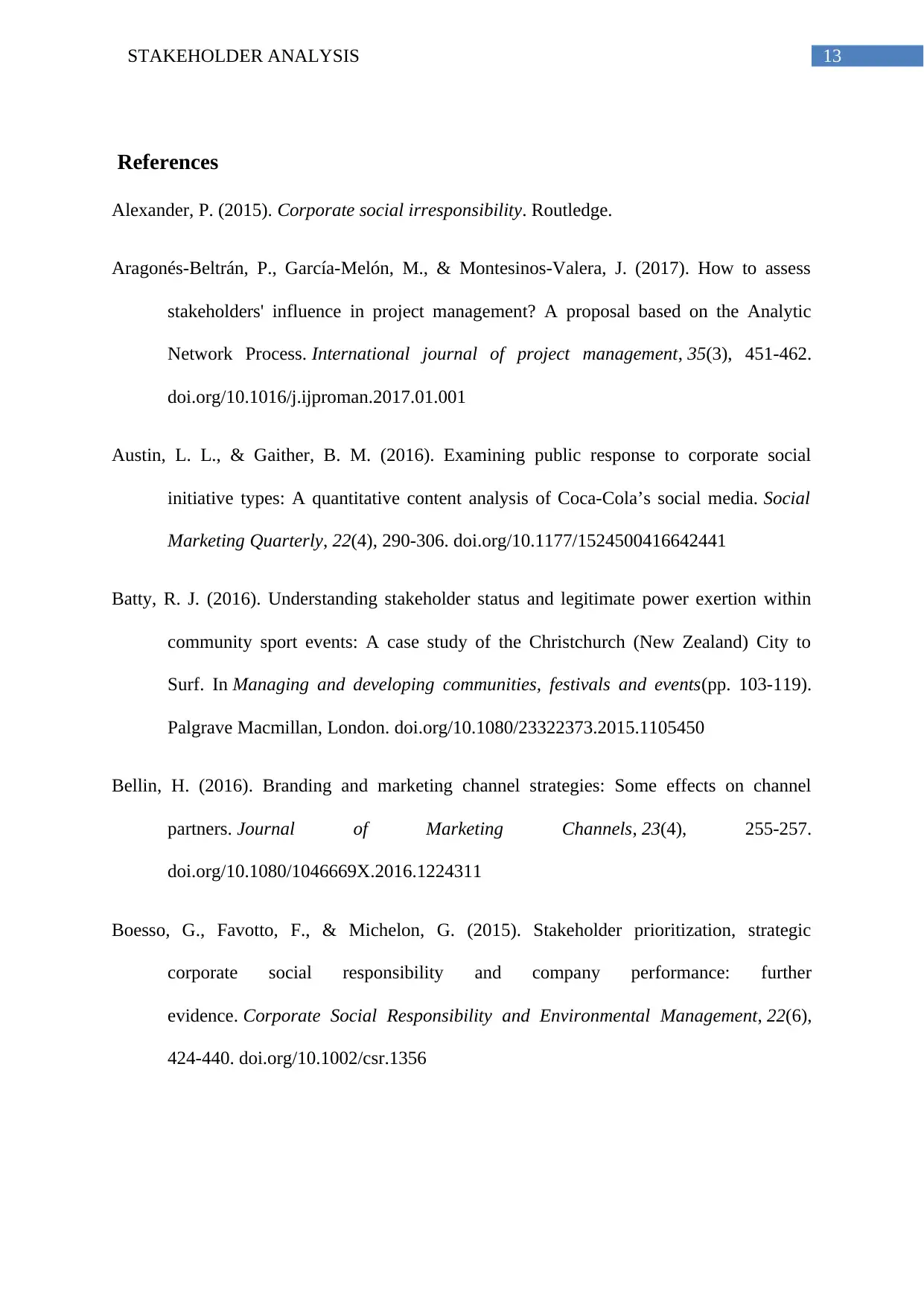
13STAKEHOLDER ANALYSIS
References
Alexander, P. (2015). Corporate social irresponsibility. Routledge.
Aragonés-Beltrán, P., García-Melón, M., & Montesinos-Valera, J. (2017). How to assess
stakeholders' influence in project management? A proposal based on the Analytic
Network Process. International journal of project management, 35(3), 451-462.
doi.org/10.1016/j.ijproman.2017.01.001
Austin, L. L., & Gaither, B. M. (2016). Examining public response to corporate social
initiative types: A quantitative content analysis of Coca-Cola’s social media. Social
Marketing Quarterly, 22(4), 290-306. doi.org/10.1177/1524500416642441
Batty, R. J. (2016). Understanding stakeholder status and legitimate power exertion within
community sport events: A case study of the Christchurch (New Zealand) City to
Surf. In Managing and developing communities, festivals and events(pp. 103-119).
Palgrave Macmillan, London. doi.org/10.1080/23322373.2015.1105450
Bellin, H. (2016). Branding and marketing channel strategies: Some effects on channel
partners. Journal of Marketing Channels, 23(4), 255-257.
doi.org/10.1080/1046669X.2016.1224311
Boesso, G., Favotto, F., & Michelon, G. (2015). Stakeholder prioritization, strategic
corporate social responsibility and company performance: further
evidence. Corporate Social Responsibility and Environmental Management, 22(6),
424-440. doi.org/10.1002/csr.1356
References
Alexander, P. (2015). Corporate social irresponsibility. Routledge.
Aragonés-Beltrán, P., García-Melón, M., & Montesinos-Valera, J. (2017). How to assess
stakeholders' influence in project management? A proposal based on the Analytic
Network Process. International journal of project management, 35(3), 451-462.
doi.org/10.1016/j.ijproman.2017.01.001
Austin, L. L., & Gaither, B. M. (2016). Examining public response to corporate social
initiative types: A quantitative content analysis of Coca-Cola’s social media. Social
Marketing Quarterly, 22(4), 290-306. doi.org/10.1177/1524500416642441
Batty, R. J. (2016). Understanding stakeholder status and legitimate power exertion within
community sport events: A case study of the Christchurch (New Zealand) City to
Surf. In Managing and developing communities, festivals and events(pp. 103-119).
Palgrave Macmillan, London. doi.org/10.1080/23322373.2015.1105450
Bellin, H. (2016). Branding and marketing channel strategies: Some effects on channel
partners. Journal of Marketing Channels, 23(4), 255-257.
doi.org/10.1080/1046669X.2016.1224311
Boesso, G., Favotto, F., & Michelon, G. (2015). Stakeholder prioritization, strategic
corporate social responsibility and company performance: further
evidence. Corporate Social Responsibility and Environmental Management, 22(6),
424-440. doi.org/10.1002/csr.1356
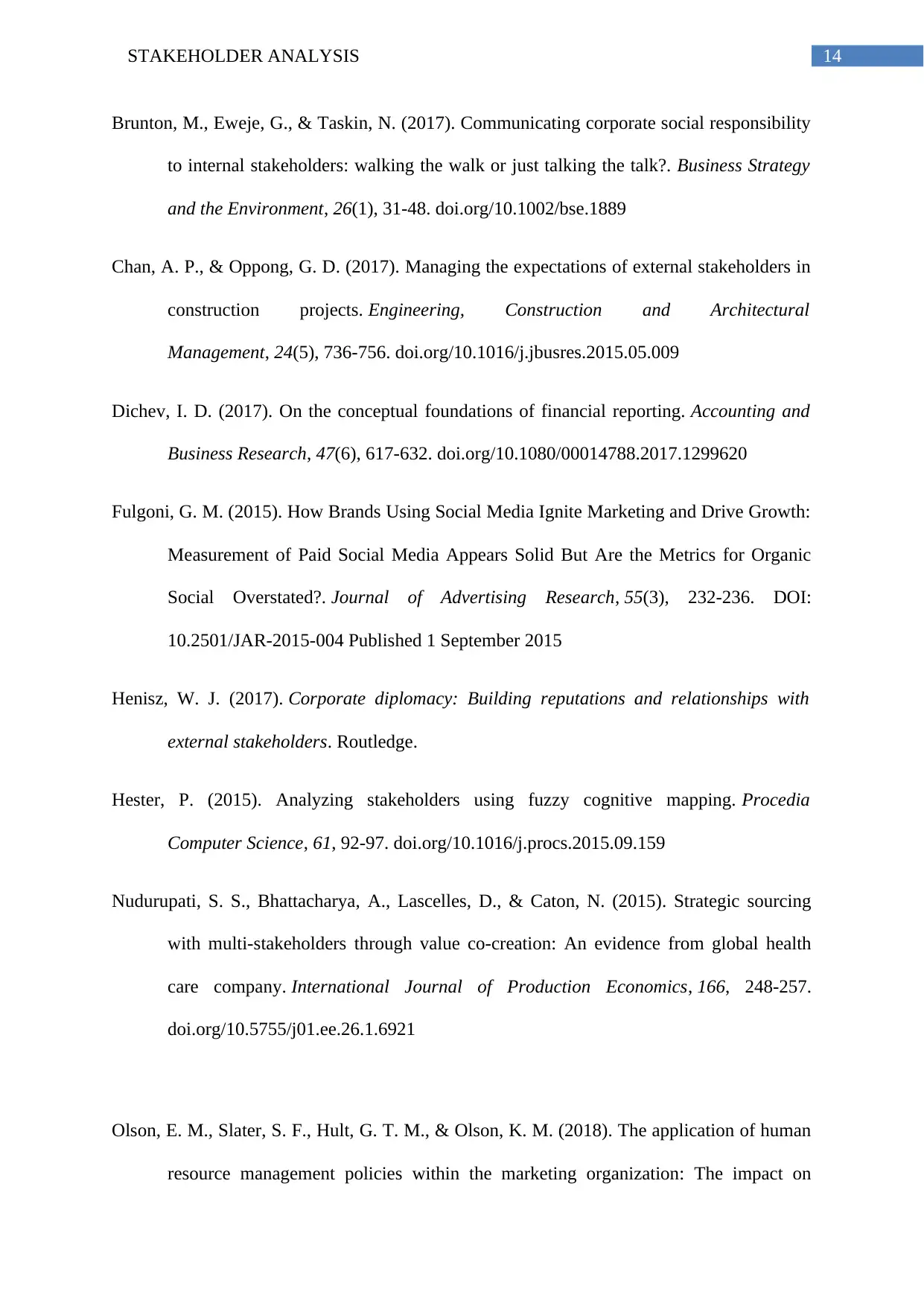
14STAKEHOLDER ANALYSIS
Brunton, M., Eweje, G., & Taskin, N. (2017). Communicating corporate social responsibility
to internal stakeholders: walking the walk or just talking the talk?. Business Strategy
and the Environment, 26(1), 31-48. doi.org/10.1002/bse.1889
Chan, A. P., & Oppong, G. D. (2017). Managing the expectations of external stakeholders in
construction projects. Engineering, Construction and Architectural
Management, 24(5), 736-756. doi.org/10.1016/j.jbusres.2015.05.009
Dichev, I. D. (2017). On the conceptual foundations of financial reporting. Accounting and
Business Research, 47(6), 617-632. doi.org/10.1080/00014788.2017.1299620
Fulgoni, G. M. (2015). How Brands Using Social Media Ignite Marketing and Drive Growth:
Measurement of Paid Social Media Appears Solid But Are the Metrics for Organic
Social Overstated?. Journal of Advertising Research, 55(3), 232-236. DOI:
10.2501/JAR-2015-004 Published 1 September 2015
Henisz, W. J. (2017). Corporate diplomacy: Building reputations and relationships with
external stakeholders. Routledge.
Hester, P. (2015). Analyzing stakeholders using fuzzy cognitive mapping. Procedia
Computer Science, 61, 92-97. doi.org/10.1016/j.procs.2015.09.159
Nudurupati, S. S., Bhattacharya, A., Lascelles, D., & Caton, N. (2015). Strategic sourcing
with multi-stakeholders through value co-creation: An evidence from global health
care company. International Journal of Production Economics, 166, 248-257.
doi.org/10.5755/j01.ee.26.1.6921
Olson, E. M., Slater, S. F., Hult, G. T. M., & Olson, K. M. (2018). The application of human
resource management policies within the marketing organization: The impact on
Brunton, M., Eweje, G., & Taskin, N. (2017). Communicating corporate social responsibility
to internal stakeholders: walking the walk or just talking the talk?. Business Strategy
and the Environment, 26(1), 31-48. doi.org/10.1002/bse.1889
Chan, A. P., & Oppong, G. D. (2017). Managing the expectations of external stakeholders in
construction projects. Engineering, Construction and Architectural
Management, 24(5), 736-756. doi.org/10.1016/j.jbusres.2015.05.009
Dichev, I. D. (2017). On the conceptual foundations of financial reporting. Accounting and
Business Research, 47(6), 617-632. doi.org/10.1080/00014788.2017.1299620
Fulgoni, G. M. (2015). How Brands Using Social Media Ignite Marketing and Drive Growth:
Measurement of Paid Social Media Appears Solid But Are the Metrics for Organic
Social Overstated?. Journal of Advertising Research, 55(3), 232-236. DOI:
10.2501/JAR-2015-004 Published 1 September 2015
Henisz, W. J. (2017). Corporate diplomacy: Building reputations and relationships with
external stakeholders. Routledge.
Hester, P. (2015). Analyzing stakeholders using fuzzy cognitive mapping. Procedia
Computer Science, 61, 92-97. doi.org/10.1016/j.procs.2015.09.159
Nudurupati, S. S., Bhattacharya, A., Lascelles, D., & Caton, N. (2015). Strategic sourcing
with multi-stakeholders through value co-creation: An evidence from global health
care company. International Journal of Production Economics, 166, 248-257.
doi.org/10.5755/j01.ee.26.1.6921
Olson, E. M., Slater, S. F., Hult, G. T. M., & Olson, K. M. (2018). The application of human
resource management policies within the marketing organization: The impact on
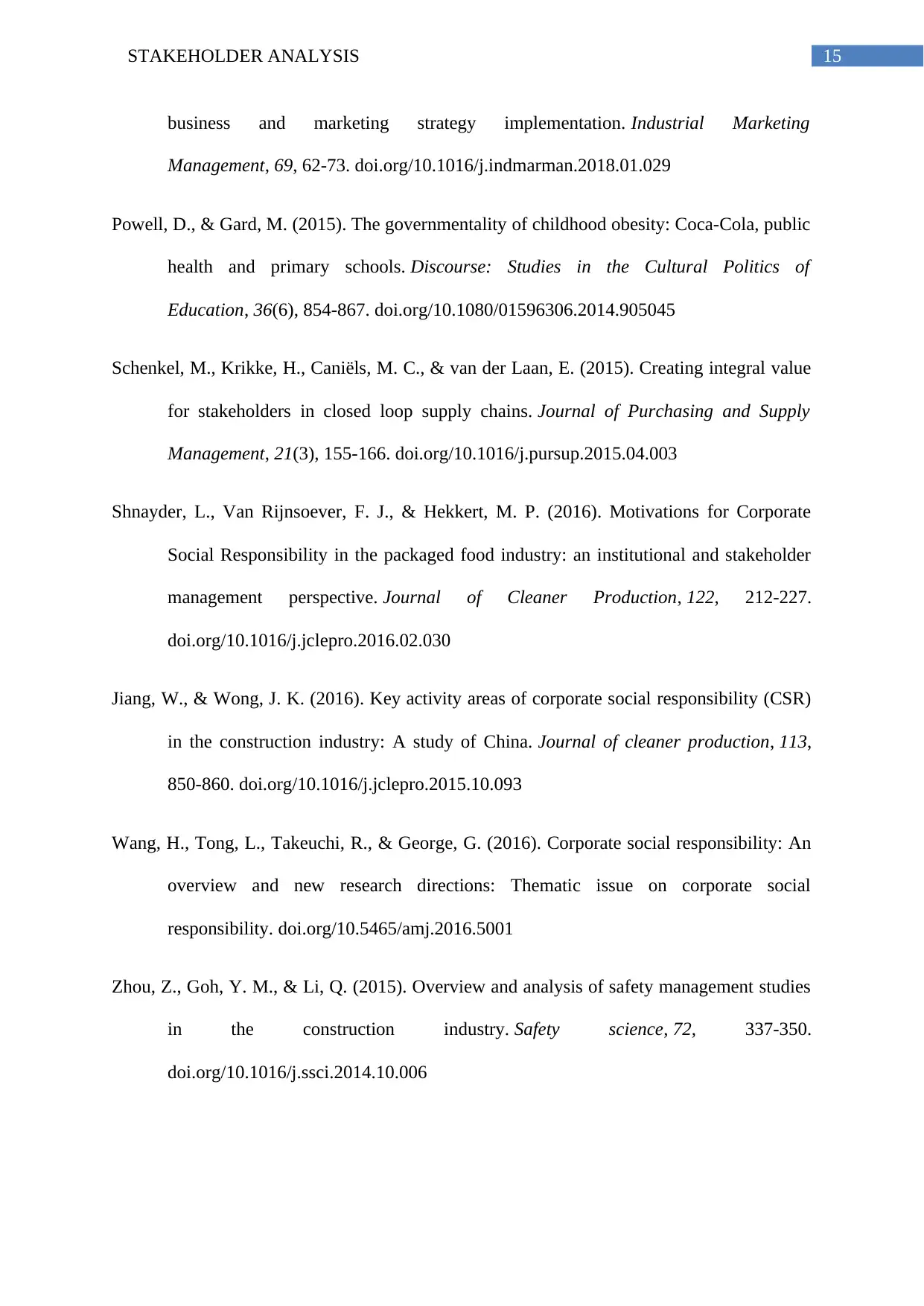
15STAKEHOLDER ANALYSIS
business and marketing strategy implementation. Industrial Marketing
Management, 69, 62-73. doi.org/10.1016/j.indmarman.2018.01.029
Powell, D., & Gard, M. (2015). The governmentality of childhood obesity: Coca-Cola, public
health and primary schools. Discourse: Studies in the Cultural Politics of
Education, 36(6), 854-867. doi.org/10.1080/01596306.2014.905045
Schenkel, M., Krikke, H., Caniëls, M. C., & van der Laan, E. (2015). Creating integral value
for stakeholders in closed loop supply chains. Journal of Purchasing and Supply
Management, 21(3), 155-166. doi.org/10.1016/j.pursup.2015.04.003
Shnayder, L., Van Rijnsoever, F. J., & Hekkert, M. P. (2016). Motivations for Corporate
Social Responsibility in the packaged food industry: an institutional and stakeholder
management perspective. Journal of Cleaner Production, 122, 212-227.
doi.org/10.1016/j.jclepro.2016.02.030
Jiang, W., & Wong, J. K. (2016). Key activity areas of corporate social responsibility (CSR)
in the construction industry: A study of China. Journal of cleaner production, 113,
850-860. doi.org/10.1016/j.jclepro.2015.10.093
Wang, H., Tong, L., Takeuchi, R., & George, G. (2016). Corporate social responsibility: An
overview and new research directions: Thematic issue on corporate social
responsibility. doi.org/10.5465/amj.2016.5001
Zhou, Z., Goh, Y. M., & Li, Q. (2015). Overview and analysis of safety management studies
in the construction industry. Safety science, 72, 337-350.
doi.org/10.1016/j.ssci.2014.10.006
business and marketing strategy implementation. Industrial Marketing
Management, 69, 62-73. doi.org/10.1016/j.indmarman.2018.01.029
Powell, D., & Gard, M. (2015). The governmentality of childhood obesity: Coca-Cola, public
health and primary schools. Discourse: Studies in the Cultural Politics of
Education, 36(6), 854-867. doi.org/10.1080/01596306.2014.905045
Schenkel, M., Krikke, H., Caniëls, M. C., & van der Laan, E. (2015). Creating integral value
for stakeholders in closed loop supply chains. Journal of Purchasing and Supply
Management, 21(3), 155-166. doi.org/10.1016/j.pursup.2015.04.003
Shnayder, L., Van Rijnsoever, F. J., & Hekkert, M. P. (2016). Motivations for Corporate
Social Responsibility in the packaged food industry: an institutional and stakeholder
management perspective. Journal of Cleaner Production, 122, 212-227.
doi.org/10.1016/j.jclepro.2016.02.030
Jiang, W., & Wong, J. K. (2016). Key activity areas of corporate social responsibility (CSR)
in the construction industry: A study of China. Journal of cleaner production, 113,
850-860. doi.org/10.1016/j.jclepro.2015.10.093
Wang, H., Tong, L., Takeuchi, R., & George, G. (2016). Corporate social responsibility: An
overview and new research directions: Thematic issue on corporate social
responsibility. doi.org/10.5465/amj.2016.5001
Zhou, Z., Goh, Y. M., & Li, Q. (2015). Overview and analysis of safety management studies
in the construction industry. Safety science, 72, 337-350.
doi.org/10.1016/j.ssci.2014.10.006
1 out of 16
Related Documents
Your All-in-One AI-Powered Toolkit for Academic Success.
+13062052269
info@desklib.com
Available 24*7 on WhatsApp / Email
![[object Object]](/_next/static/media/star-bottom.7253800d.svg)
Unlock your academic potential
© 2024 | Zucol Services PVT LTD | All rights reserved.





